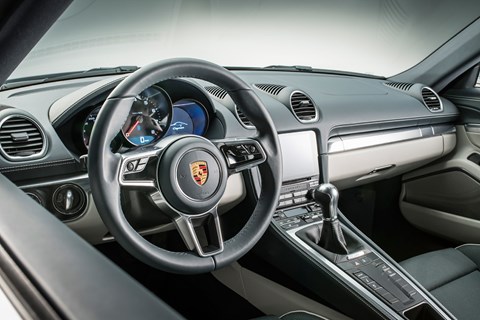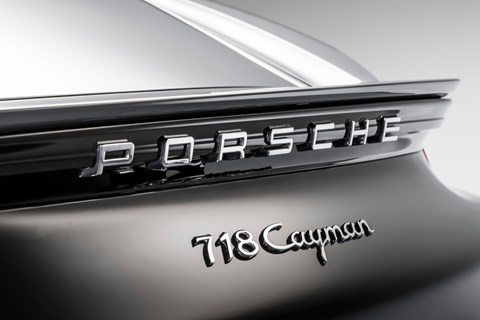► New Porsche 718 Cayman revealed
► Adopts new turbo four, like the Boxster
► Cayman costs £40k, Cayman S £49k
Always wanted a Porsche Cayman but thought it sounded a bit too good, or had too much character? Then you’re in luck! Yes, the new 718 Cayman – which follows in the footsteps of the 718 Boxster – has arrived.
Just like the new Boxster, the Cayman – which was revealed at the 2016 Beijing motor show – ditches its much-loved flat-six engine for a turbocharged four-cylinder boxer. It’s also received a cosmetic overhaul, more kit and a revamped interior.
It’s not all bad news, however. As is generally par for the course with downsized engines in performance models, the new 718 Cayman is quicker, faster and more efficient than its predecessor. Swings and roundabouts…
Tell me about this new Suba… er, Porsche engine
The entry-level 718 Cayman gets a turbocharged 2.0-litre flat-four that produces 295bhp and 280lb ft, an increase of 33bhp and 73lb ft respectively compared with the old naturally aspirated six.
Go for the hotter 718 Cayman S and you’ll get a larger 2.5-litre turbocharged four, with a variable-geometry turbocharger, that punches out 345bhp and 310lb ft; that means it’s up 34bhp and 44lb ft compared with the old Cayman S.
Not hikes to be sniffed at, then, and ones that consequently translate into significant performance gains. Porsche says the 718 Cayman, equipped with the seven-speed PDK and the optional Sport Chrono Pack, will sprint from 0-62mph in 4.7sec. That’s 0.7sec faster than the equivalent outgoing model.
The full-fat 718 Cayman S will complete the benchmark sprint in 4.2sec – yup, not far off three-point-something seconds. It’s consequently some 0.5sec quicker from 0-62mph than the outgoing Cayman S. Both are a few digits faster at the top end, too, knocking on the door of 170mph and 177mph respectively. Not bad for a four-cylinder coupe, eh?
Improved performance, but not at the cost of efficiency
As is generally the trend with downsizing, the 718 Cayman is more powerful yet more efficient; it’s cleaner and more economical across the board than the previous versions.
For example, the manual 718 Cayman is claimed to average 38mpg and emit 168g/km of CO2. The current naturally aspirated, less powerful manual Cayman averages 33.6mpg and emits 195g/km of CO2.
You can still get a manual gearbox, though; a six-speed manual is standard-fit throughout the range.
Boost or bust: turbocharged Porsche 718 Boxster revealed

What else has changed in the new 2016 718 Cayman and Cayman S?
There have been a whole host of chassis tweaks, including firmer springs, stiffer anti-roll bars and retuned dampers. Porsche claims that the steering is also ‘10% more direct’, while the rear wheels are half an inch wider. This allows for fitment of a wider tyre, boosting traction and grip. All in, the changes reputedly deliver sharper, keener handling.
Options include Porsche’s reaction-quickening Sport Chrono Package, an electronically controlled limited-slip differential and Porsche’s electronically adjustable suspension. This also cuts 10mm out of the ride height, while those looking for the most rambunctious experience can opt for PASM sport – which drops the ride height 20mm.
Stopping power has been bolstered, too, with bigger discs – and calipers from the 911 on the 718 Cayman S – helping rein in the turbocharged coupe a little more authoritatively.
It looks different, too, right?
Much like the new Boxster, the Cayman’s received a substantial cosmetic overhaul. The nose has been sharpened, the air intakes are bigger and the headlights have been redesigned. Porsche has also worked to make the Cayman’s tail look a lot wider, and has fitted new lights to suit and a fairly blatant ‘Porsche’ badge.
There are similar minor tweaks and upgrades inside, including new air vents, a 918 Spyder-inspired steering wheel and Porsche’s latest media system.

Boost in, soul out?
Judging by Ben Barry’s drive of the 718 Boxster, it’s pretty clear what effect the fitment of a turbocharged four-cylinder boxer will have on the Cayman: ‘Firing the Boxster S’s engine into life results in disappointment, unfortunately… It’s a much bigger culture shock than the switch from natural aspiration to turbo power for the 911 Carrera, and simply isn’t exotic enough.’
You can read the full first drive of the 718 Boxster S here
Why is this called the 718 again?
Because Porsche is trying to establish a connection to the race-winning Porsche 718 on the ’50s and ’60s, which – you guessed it – was powered by a flat-four engine. See, your new affordable Porsche has real cachet, honest!
How much will a Porsche 718 Cayman cost?
Go for a Porsche 718 Cayman and you’ll have to fork out £39,878. The more potent 718 Cayman S will set you back £48,834.
Both those prices are on a par with the current naturally aspirated Caymans. So, given the performance and equipment upgrades, you could argue that the new 718 is good value for money – albeit at the cost of its charm and character. We’ll find out for sure when we drive it this spring.
Read CAR magazine’s Cayman reviews here
